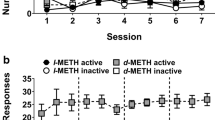Abstract
A fixed-ratio schedule of food reinforcement (FR 30) was used to study the differences in tolerance produced by peripheral injections and intraventricular infusions of mescaline hydrochloride in rats. Successive daily administrations of 10 mg mescaline/kg i.p. resulted in a decrease in behavioral disruption (tolerance). The following day, intraventricular infusion of a dose of mescaline previously shown to be approximately equal to the peripheral dose in terms of behavioral disruption was started. After tolerance to central administration of mescaline was established, 10 mg/kg of mescaline injected i.p. resulted in behavioral disruption equal to that produced by the first i.p. injection.
In a second experiment, blood pressure effects of mescaline given i.p. and intraventricularly were studied. Peripherally administered mescaline produced marked effects on caudally measured blood pressure and increased biting upon and struggling within the restraining device. Mescaline administered centrally did not appear to elicit similar cardiovascular changes. These data suggest that different mechanisms may be involved in the formation of tolerance to mescaline administered by these two routes as measured by means of a fixed ratio reinforcement schedule.
Similar content being viewed by others
References
Appel, J., Freedman, D.: Tolerance and cross-tolerance among psychomimetic drugs. Psychopharmacologia (Berl.) 13, 267–274 (1968).
Baldestrieri, A., Fontanari, D.: Acquired and crossed tolerance to mescaline, LSD-25 and BOL-148. Arch. gen. Psychiat. 1, 279–282 (1959).
Bebbington, A., Brimblecombe, R.: Actions of some toxic substances (psychomimetics) on the central nervous system. Brit. med. Bull. 25, 293–298 (1969).
Cerletti, A., Rothlin, E.: Role of 5-hydroxytryptamine in mental diseases and its antagonism to lysergic acid derivatives. Nature (Lond.) 176, 785–786 (1955).
Feldberg, W.: The action of drugs injected into the cerebral ventricles. In: S. Garattini and V. Ghetti, Eds.: Psychotropic drugs. Amsterdam: Elsevier 1957.
Freedman, D., Aghajanian, G., Ornitz, E., Rosner, B.: Patterns of tolerance to lysergic acid diethylamide and mescaline in rats. Science 127, 1173–1174 (1958).
Greenblatt, E., Osterberg, A.: Correlations of activating and lethal effects of excitatory drugs in grouped and isolated mice. J. Pharmacol. exp. Ther. 131, 115–119 (1961).
Haley, T.: Pharmacological actions from intracerebral drug injections. In: S. Garattini and V. Ghetti, Eds.: Psychotropic drugs. Amsterdam: Elsevier (1957).
Isbell, H., Miner, E., Logan, C.: Relationship of psychomimetic to antiserotonin potencies of congeners of lysergic acid diethylamide (LSD-25). Psychopharmacologia (Berl.) 1, 20–28 (1959).
Jarvik, M., Abramson, H., Hirsch, M.: Comparative subjective effects of seven drugs including lysergic acid diethylamide (LSD-25). J. abnorm. soc. Psychol. 51, 657–676 (1967).
Noble, E., Wurtman, R., Axelrod, J.: A simple and rapid method for injecting H3-norepinephrine into the lateral ventricle of the rat brain. Life Sci. 6, 281–291 (1967).
Robinson, R., Cutler, W., Lorenzo, A., Barlow, C.: Transport of sulfate, thiosulfate and iodide by choroid plexus in vitro. J. Neurochem. 15, 1169–1179 (1968).
Roth, W.: The effect of LSD, mescaline and d-amphetamine on the evoked “secondary discharge”. Psychopharmacologia (Berl.) 9, 253–258 (1966).
Rothlin, E.: Lysergic acid diethylamide and related substances. Ann. N.Y. Acad. Sci. 66, 668–676 (1957).
Speck, L.: Toxicity and effects of increasing doses of mescaline. J. Pharmacol. exp. Ther. 119, 78–84 (1957).
Wolbach, A., Isbell, H., Miner, E.: Cross tolerance between mescaline and LSD-25 with a comparison of the mescaline and LSD reactions. Psychopharmacologia (Berl.) 3, 1–14 (1962).
Winter, J.: Behavioral effects of N,N-diethyltryptamine: Absence of antagonism by xylamidine tosylate. J. Pharmacol. exp. Ther. 169, 7–16 (1969).
Author information
Authors and Affiliations
Additional information
Supported in part by a Grant from the USPHS-MH-08565. H.A.T. is a predoctoral fellow in the Department of Psychology, University of Minnesota
Rights and permissions
About this article
Cite this article
Tilson, H.A., Sparber, S.B. Differences in tolerance to mescaline produced by peripheral and direct central administration. Psychopharmacologia 19, 313–323 (1971). https://doi.org/10.1007/BF00404375
Received:
Revised:
Issue Date:
DOI: https://doi.org/10.1007/BF00404375




